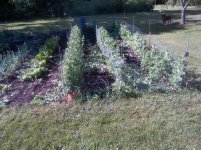From previous years, I have a 50 x 100 garden with 8 ft deer netting, 2 ft chicken wire bottom, all attached to 4 ft field fence....all mounted to 6 ft T-post, 6 inch wood corner posts. The deer netting is held up by 10 ft pvc, schedule 40, 1/2 water pipe attached to the T-posts. I built 7 ft wide entrances midway on both ends. Gates to the entrances are built from the pvc pipe frame to which some other welded wire fence that I had laying around was attached. The gates are simply lifted off of hooks set in the 6 inch posts.
This all worked great for my walk behind tilling days. But now, with my B2620, I think I'll extend the garden, take down one side, rebuild the other corners (for extension), and make the new side removable. At 80 years old, this expansion might still be worth it. :drink: Cheers, Mike
BTW...we have lots of deer, rabbits, squirrels and coons. The coons have to be trapped. And......I'm thinking of buying that 5 ft Tiller to go in that new garden area. We'll see.

